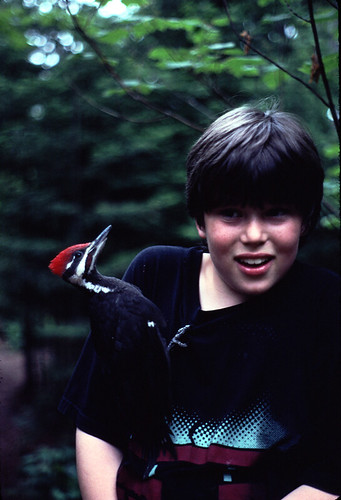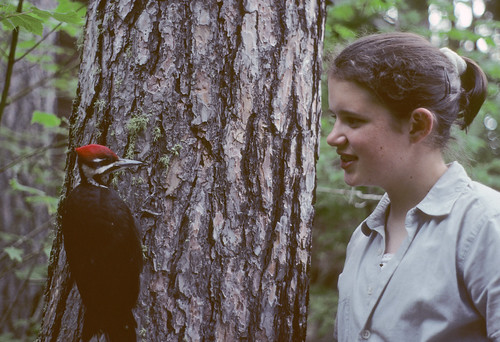This year, the American Birding Association named the Pileated Woodpecker their Bird of the Year. I’ve been going through old For the Birds transcripts and blog posts looking back at all the things I’ve written about Pileateds over the years. In January 1997, just months before I had my own personal encounter raising a baby Pileated Woodpecker, I read what a Lutheran minister named John Bachman wrote to his friend John James Audubon, who published it in his Birds of America.
Bachman took an entire six-egg clutch from a Pileated Woodpecker nest to see if the birds would start a new clutch. When they renested, this time producing five eggs, he waited until the young were occasionally peeping out of the hole. He wrote:
I carried them home, to judge of their habits in confinement, and attempted to raise them.
I found it exceedingly difficult to entice them to open their bill in order to feed them. They were sullen and cross, nay, three died in a few days; but the others, having been fed on grasshoppers forcibly introduced into their mouths, were raised. In a short time they began picking up the grasshoppers thrown into their cage, and were fully fed with cornmeal, which they preferred eating dry.
Their whole employment consisted in attempting to escape from their prison, regularly demolishing one every two days, although made of pine boards of tolerable thickness. I at last had one constructed with oak boards at the back and sides, and rails of the same in front. This was too much for them, and their only comfort was in passing and holding their bills through the hard bars.
In the morning after receiving water, which they drank freely, they invariably upset the cup or saucer, and although this was large and flattish, they regularly turned it quite over. After this they attacked the trough which contained their food, and soon broke it to pieces, and when perchance I happened to approach them with my hand, they made passes at it with their powerful bills with great force.
I kept them in this manner until winter. They were at all times uncleanly and unsociable birds. On opening the door of my study one morning, one of them dashed off by me, alighted on an apple-tree near the house, climbed some distance, and kept watching me from one side and then the other, as if to ask what my intentions were. I walked into my study—the other was hammering at my books.
They had broken one of the bars of the cage, and must have been at liberty for some hours, judging by the mischief they had done. Tired of my pets, I opened the door, and this last one hearing the voice of his brother, flew towards him and alighted on the same tree. They remained about half an hour, as if consulting each other, after which, taking to their wings together, they flew off in a southern direction, and with much more ease than could have been expected from birds so long kept in captivity. The ground was covered with snow, and I never more saw them. No birds of this species ever bred since in the hole spoken of in this instance.
I'm very glad that those parent Pileateds steered clear of that elm tree after that. I raised one baby Pileated Woodpecker during my years as a rehabber. Gepetto was most assuredly never once “sullen and cross,” nor did he do any damage to my house—I gave him plenty of things to play with, and he was incredibly gentle when he was sitting on my shoulder or arm, or on any of my children.
I learned a lot about Pileated Woodpeckers from my experience, all of it making me love Pileated Woodpeckers even more than I already did. I stayed with Gepetto for two weeks when he was learning to be independent, so I was reasonably assured that he could find his own natural food and knew how to elude danger.
 |
| Gepetto was very gentle, but his claws were pretty sharp clinging to a thin t-shirt. |
I wonder how long Bachman's two survivors lasted after they escaped. I sure hope he treated his parishioners with more kindness and understanding than he did those poor baby birds. Audubon named two species for him, Bachman's Sparrow and the extinct Bachman's Warbler. Audubon himself never saw a Bachman's Warbler—Bachman shot and gave the specimens to Audubon, who named the species in Bachman's honor in 1833. Bachman was a slave-owner who used Scripture to justify that abomination. I'd love to see the American Ornithological Society change the names of these birds to something reflecting the birds themselves, not to honor the white supremacist who shot them.



